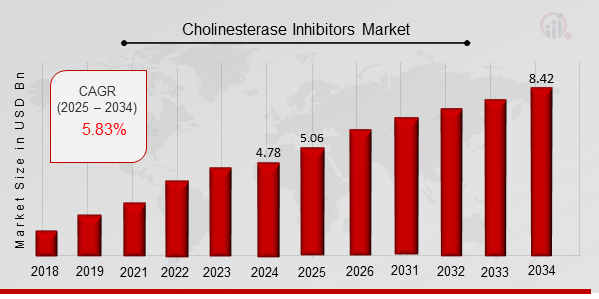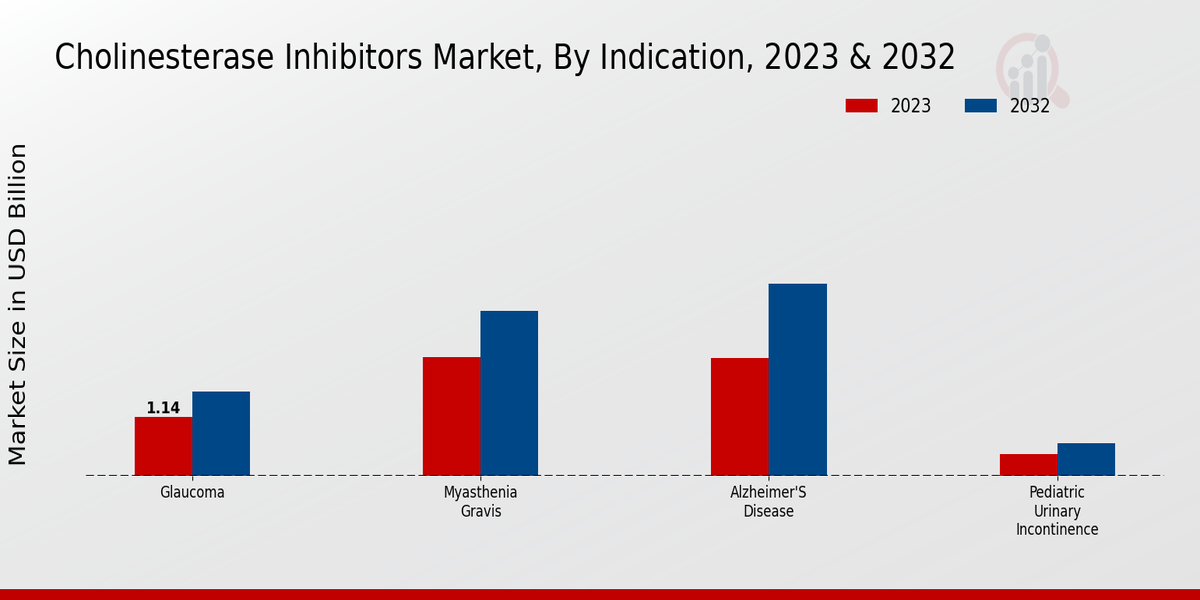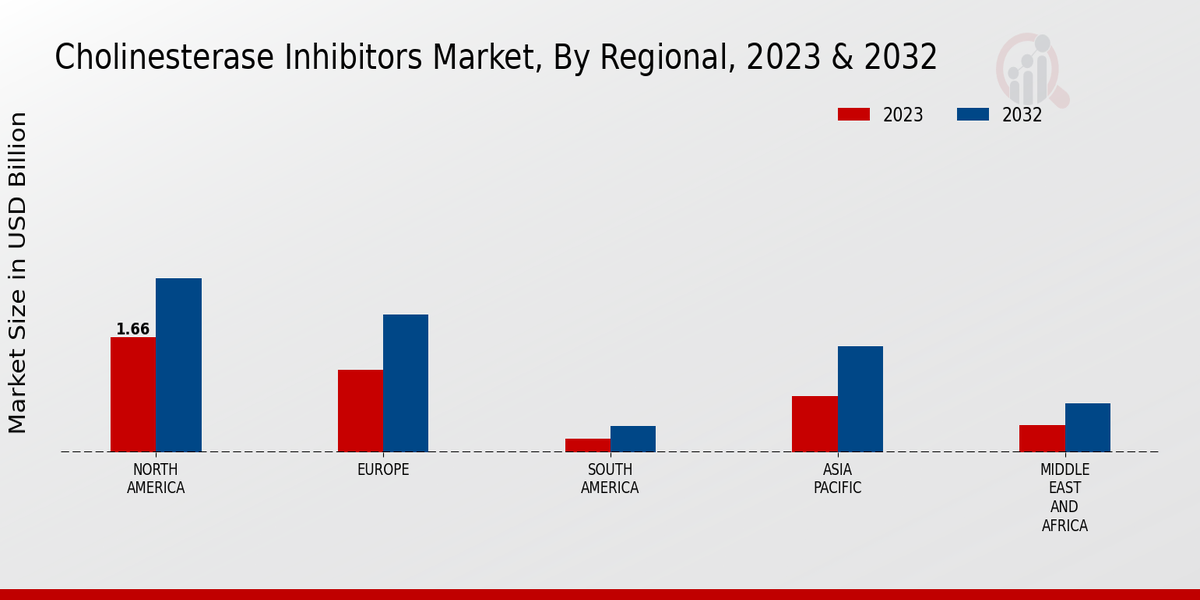Cholinesterase Inhibitors Market Overview:
As per MRFR analysis, the Cholinesterase Inhibitors Market Size was estimated at 4.78 (USD Billion) in 2024. The Cholinesterase Inhibitors Market Industry is expected to grow from 5.06 (USD Billion) in 2025 to 8.42 (USD Billion) till 2034, at a CAGR (growth rate) is expected to be around 5.83% during the forecast period (2025 - 2034).
Key Cholinesterase Inhibitors Market Trends Highlighted
The key market trends in the Cholinesterase Inhibitors Market include the increasing prevalence of neurological disorders, especially Alzheimer’s and Parkinson’s diseases, which results in the increased need for treatment. There are also other factors contributing to the growth of the market, which include advances in technologies in the process of drug discovery and development that have led to the development of new cholinesterase inhibitors that are more potent and safe.
In addition to that, more and more steps that are taken by the government and the industry to help cope with the problem of neurological disorders are opening the doors to broaden the market. The growing emphasis on personalized medicine and precision therapy approaches is further fueling the demand for cholinesterase inhibitors tailored to specific patient needs.

Source: Primary Research, Secondary Research, MRFR Database and Analyst Review
Cholinesterase Inhibitors Market Drivers
Increasing Prevalence of Alzheimer's Disease
Alzheimer’s disease is a progressive neurodegenerative disorder characterized by memory loss, cognitive impairment, and behavioral changes. It is the most common form of dementia, and it is estimated to affect over 55 million people worldwide. The prevalence of Alzheimer’s disease is rising as the population is aging, and this is projected to drive the growth of the Cholinesterase Inhibitors Market Industry across the forecast period. Cholinesterase inhibitors are a class of drugs used to treat the symptoms of Alzheimer’s disease.
They work by increasing the levels of acetylcholine in the brain, which is a neurotransmitter involved with memory and cognition. Cholinesterase inhibitors have been shown to improve cognitive function and reduce the symptoms of Alzheimer’s disease in some patients. The growing prevalence of Alzheimer’s disease is a key driver of the Cholinesterase Inhibitors Market Industry. As more people are diagnosed with Alzheimer’s disease, the demand for cholinesterase inhibitors is also expected to rise.
This is anticipated to drive significant growth in the Cholinesterase Inhibitors Market Industry, and this trend is expected to continue across the forecast period.
Rising Demand for Early Diagnosis and Treatment
Early diagnosis and treatment of Alzheimer's disease is important to slow the progression of the disease and improve the quality of life for patients. Cholinesterase inhibitors are one of the few drugs that have been shown to be effective in treating the symptoms of Alzheimer's disease, and they are often used in the early stages of the disease. The rising demand for early diagnosis and treatment of Alzheimer's disease is another major driver of the Cholinesterase Inhibitors Market Industry.As more people are diagnosed with Alzheimer's disease at an early stage, the demand for cholinesterase inhibitors is also expected to increase. This is expected to lead to significant growth in the Cholinesterase Inhibitors Market Industry over the forecast period.
Government Initiatives to Support Alzheimer's Disease Research
Governments around the world are increasingly recognizing the importance of Alzheimer's disease research. This is leading to increased funding for research into new treatments for Alzheimer's disease, including cholinesterase inhibitors. Government initiatives to support Alzheimer's disease research are another major driver of the Cholinesterase Inhibitors Market Industry.
As governments continue to invest in Alzheimer's disease research, the development of new and more effective cholinesterase inhibitors is expected to accelerate.This is expected to lead to significant growth in the Cholinesterase Inhibitors Market Industry over the forecast period.
Cholinesterase Inhibitors Market Segment Insights:
Cholinesterase Inhibitors Market Indication Insights
The Cholinesterase Inhibitors Market is segmented by indication into Alzheimer's Disease, Myasthenia Gravis, Glaucoma, and Pediatric Urinary Incontinence. Alzheimer's Disease is the most common indication for cholinesterase inhibitors, accounting for over 50% of the global market revenue in 2023. The increasing prevalence of Alzheimer's Disease, particularly among the elderly population, is driving the growth of this segment. Cholinesterase inhibitors are used to improve cognitive function and slow the progression of the disease. Myasthenia Gravis is another major indication for cholinesterase inhibitors, accounting for around 20% of the global market revenue in 2023.
Myasthenia Gravis is a neuromuscular disorder that causes muscle weakness. Cholinesterase inhibitors are used to improve muscle strength and function in patients with Myasthenia Gravis. Glaucoma is a condition that damages the optic nerve, leading to vision loss. Cholinesterase inhibitors are used to lower intraocular pressure, which can help to prevent or slow the progression of Glaucoma. The growing prevalence of Glaucoma, especially among the elderly population, is contributing to the growth of this segment. Pediatric Urinary Incontinence is a condition that affects children and is characterized by the involuntary loss of urine.
Cholinesterase inhibitors are used to improve bladder control and reduce the frequency of incontinence episodes. The increasing prevalence of chronic diseases such as Alzheimer's Disease and Myasthenia Gravis, along with the growing demand for effective treatment options, is expected to drive the growth of the Cholinesterase Inhibitors Market in the coming years.

Source: Primary Research, Secondary Research, MRFR Database and Analyst Review
Cholinesterase Inhibitors Market Drug Class Insights
The Cholinesterase Inhibitors Market is segmented based on drug class into reversible cholinesterase inhibitors, irreversible cholinesterase inhibitors, and acetylcholinesterase inhibitors. The Cholinesterase Inhibitors Market was valued at USD 4.26 billion in 2023, and it is projected to register a CAGR of 5.83% over the forecast period from 2024 to 2032. The market growth is attributed to the increasing prevalence of neurological disorders, such as Alzheimer's disease and Parkinson's disease, which require cholinesterase inhibitors for treatment.
Reversible cholinesterase inhibitors are the most commonly used class of cholinesterase inhibitors. They are well-tolerated and have a low risk of side effects. Irreversible cholinesterase inhibitors are less commonly used due to their potential for side effects, such as muscle weakness and respiratory depression. Acetylcholinesterase inhibitors are a newer class of cholinesterase inhibitors that are being investigated for the treatment of Alzheimer's disease. Currently, the reversible cholinesterase inhibitors segment holds the largest market share.
However, the acetylcholinesterase inhibitors segment is expected to grow at the highest CAGR during the forecast period. This growth is attributed to the increasing research and development activities in this segment.
Cholinesterase Inhibitors Market Route of Administration Insights
The Cholinesterase Inhibitors Market is segmented into various routes of administration, including oral, intravenous, ophthalmic, and transdermal. Among these, the oral route of administration is anticipated to dominate the market, accounting for a revenue share of around 60% in 2024.
The oral route offers several advantages, such as ease of administration, patient convenience, and cost-effectiveness. Intravenous administration is primarily used in hospital settings for patients with severe conditions that require rapid drug delivery. Ophthalmic administration is employed for the treatment of eye-related conditions, while transdermal administration involves the application of medication through the skin.
The market for transdermal cholinesterase inhibitors is expected to witness significant growth due to the increasing adoption of non-invasive drug delivery methods.
Cholinesterase Inhibitors Market Product Type Insights
Branded Medications and Generic Medications are the two main product types in the Global Cholinesterase Inhibitors Market. Branded Medications held a larger market share in 2023, owing to factors such as strong brand recognition, higher efficacy, and established distribution channels.
However, Generic Medications are expected to gain significant market share in the coming years due to their lower cost and increasing acceptance among consumers. The market growth of Generic Medications is also driven by the increasing number of patent expirations for Branded Medications, which has opened up opportunities for generic manufacturers to enter the market.
As a result, the Cholinesterase Inhibitors Market is expected to witness a significant increase in the demand for Generic Medications in the future.
Cholinesterase Inhibitors Market Distribution Channel Insights
Distribution Channel Insights and Overview The distribution channel segment is a critical aspect of the Global Cholinesterase Inhibitors Market, influencing product availability and revenue generation. The market is primarily catered to by three main channels: Hospital Pharmacies:
These facilities serve as major distribution points for Cholinesterase Inhibitors, particularly for patients with acute conditions requiring immediate access to medications. Due to their direct connection to healthcare providers, hospital pharmacies account for a significant share of the market revenue. Retail Pharmacies: Retail pharmacies offer convenient access to Cholinesterase Inhibitors for patients with chronic conditions or those needing refills.
Their presence in various locations, including urban and rural areas, makes them an important channel for market growth. Online Pharmacies: The rise of e-commerce has led to the emergence of online pharmacies, providing an alternative distribution channel for Cholinesterase Inhibitors. These platforms offer convenience, price transparency, and home delivery, which are driving their increasing popularity among consumers.
Cholinesterase Inhibitors Market Regional Insights
The Cholinesterase Inhibitors Market is segmented regionally into North America, Europe, APAC, South America, and MEA. North America is expected to hold the largest market share due to the high prevalence of Alzheimer's disease and other neurological disorders, as well as the presence of key market players. Europe is expected to be the second-largest market, followed by APAC.
The APAC region is expected to witness significant growth due to the increasing geriatric population and rising awareness of cholinesterase inhibitors. South America and MEA are expected to have a smaller market share but are expected to grow at a steady pace.
In 2023, North America is projected to be valued at 1.661 billion USD, increasing to 2.513 billion USD by 2032. Europe is estimated to reach 1.192 billion USD in 2023 and 1.984 billion USD in 2032. The South America market is forecasted at 0.199 billion USD in 2023 and 0.372 billion USD in 2032. The Asia Pacific region is expected to grow from 0.811 billion USD in 2023 to 1.529 billion USD in 2032. The Middle East and Africa market is estimated at 0.397 billion USD in 2023 and 0.703 billion USD in 2032.

Source: Primary Research, Secondary Research, MRFR Database and Analyst Review
Cholinesterase Inhibitors Market Key Players And Competitive Insights:
Major players in Cholinesterase Inhibitors Market industry are constantly engaged in research and development activities to strengthen their product portfolios and stay competitive in the market. Collaborations and partnerships between key players are also prevalent, enabling them to share knowledge, resources, and expertise to accelerate Cholinesterase Inhibitors Market development. Leading Cholinesterase Inhibitors Market players focus on expanding their geographic reach by establishing new production facilities and distribution channels in emerging markets. They also invest in marketing and promotional activities to raise awareness about their products and build strong brand recognition. The Cholinesterase Inhibitors Market Competitive Landscape is dynamic and constantly evolving, with new entrants, mergers, and acquisitions shaping the industry landscape.
Novartis, a leading company in the Cholinesterase Inhibitors Market, boasts a robust product portfolio that includes Exelon and Galantamine. The company has a strong presence in various regions across the globe and is committed to developing innovative treatments for neurological conditions. Novartis's focus on research and development, coupled with its extensive commercialization capabilities, positions it as a formidable player in the market.
Pfizer, another major competitor in the Cholinesterase Inhibitors Market, offers a range of products, including Aricept, for the treatment of Alzheimer's disease. The company has a broad global footprint and leverages its extensive distribution network to ensure widespread availability of its products. Pfizer invests heavily in research and development, particularly in the areas of neuroscience and neurology, to enhance its product offerings and cater to the evolving needs of patients.
Key Companies in the Cholinesterase Inhibitors Market Include:
- Merck Co., Inc.
- Johnson Johnson
- AbbVie Inc.
- AstraZeneca plc
- Mylan N.V.
- Eisai Co., Ltd.
- Lupin Limited
- GlaxoSmithKline plc
- Sun Pharmaceutical Industries Ltd.
- Teva Pharmaceutical Industries Ltd.
- Reddy's Laboratories Ltd.
- Novartis AG
- Actavis
- Daiichi Sankyo Company, Limited
- Pfizer Inc.
Cholinesterase Inhibitors Market Industry Developments
The Cholinesterase Inhibitors Market is projected to reach USD 7.1 billion by 2032, exhibiting a CAGR of 5.83% during the forecast period (2024-2032). Key factors driving market growth include the increasing prevalence of Alzheimer's disease and other neurological disorders, rising demand for minimally invasive surgical procedures, and technological advancements in drug delivery systems.
Recent news developments include the FDA approval of Roche's gantenerumab for the treatment of Alzheimer's disease, and the initiation of clinical trials for novel cholinesterase inhibitors with improved efficacy and reduced side effects. Key market players are focusing on strategic partnerships and acquisitions to expand their product portfolios and gain a competitive edge. For instance, in 2023, Novartis acquired Cadent Therapeutics, a company specializing in the development of treatments for neurodegenerative diseases, including cholinesterase inhibitors.
Cholinesterase Inhibitors Market Segmentation Insights
- Cholinesterase Inhibitors Market Indication Outlook
- Alzheimer's Disease
- Myasthenia Gravis
- Glaucoma
- Pediatric Urinary Incontinence
- Cholinesterase Inhibitors Market Drug Class Outlook
- Reversible Cholinesterase Inhibitors
- Irreversible Cholinesterase Inhibitors
- Acetylcholinesterase Inhibitors
- Cholinesterase Inhibitors Market Route of Administration Outlook
- Oral
- Intravenous
- Ophthalmic
- Transdermal
- Cholinesterase Inhibitors Market Product Type Outlook
- Branded Medications
- Generic Medications
- Cholinesterase Inhibitors Market Distribution Channel Outlook
- Hospital Pharmacies
- Retail Pharmacies
- Online Pharmacies
- Cholinesterase Inhibitors Market Regional Outlook
- North America
- Europe
- South America
- Asia Pacific
- Middle East and Africa
| Report Attribute/Metric |
Details |
|
Market Size 2024
|
4.78 (USD Billion)
|
|
Market Size 2025
|
5.06 (USD Billion)
|
|
Market Size 2034
|
8.42 (USD Billion)
|
|
Compound Annual Growth Rate (CAGR)
|
5.83 % (2025 - 2034)
|
|
Report Coverage
|
Revenue Forecast, Competitive Landscape, Growth Factors, and Trends
|
|
Base Year
|
2024
|
|
Market Forecast Period
|
2025 - 2034
|
|
Historical Data
|
2020 - 2024
|
| Market Forecast Units |
USD Billion |
| Key Companies Profiled |
Merck Co., Inc., Johnson Johnson, AbbVie Inc., AstraZeneca plc, Mylan N.V., Eisai Co., Ltd., Lupin Limited, GlaxoSmithKline plc, Sun Pharmaceutical Industries Ltd., Teva Pharmaceutical Industries Ltd., Dr. Reddy's Laboratories Ltd., Novartis AG, Actavis, Daiichi Sankyo Company, Limited, Pfizer Inc. |
| Segments Covered |
Indication, Drug Class, Route of Administration, Product Type, Distribution Channel, Regional |
| Key Market Opportunities |
Rising prevalence of neurodegenerative diseases Growing geriatric population Advancements in drug discovery Untapped potential in emerging markets Increasing research and development initiatives |
| Key Market Dynamics |
1 Rising Prevalence of Neurodegenerative Diseases2 Government Initiatives and Funding for Research3 Technological Advancements in Drug Development4 Expanding Applications in Surgery and Anesthesia5 Growing Focus on Noninvasive Treatments |
| Countries Covered |
North America, Europe, APAC, South America, MEA |
Frequently Asked Questions (FAQ) :
The Cholinesterase Inhibitors Market size was valued at USD 4.26 billion in 2023 and is projected to reach USD 8.42 billion by 2034, exhibiting a CAGR of 5.83% during the forecast period.
North America is anticipated to dominate the global cholinesterase inhibitors market, accounting for the largest revenue share in 2023. The presence of key players, well-established healthcare infrastructure, and high awareness about cholinesterase inhibitors contribute to the region's dominance.
Cholinesterase inhibitors are primarily used in the treatment of Alzheimer's disease and other neurodegenerative disorders. They are also being explored for their potential in treating myasthenia gravis, glaucoma, and certain types of poisoning.
Major players in the Cholinesterase Inhibitors Market include Novartis, Lundbeck, Eisai, AstraZeneca, and Mylan. These companies are engaged in research and development, manufacturing, and marketing of cholinesterase inhibitors.
The rising prevalence of neurodegenerative disorders, increasing awareness about the benefits of cholinesterase inhibitors in managing these conditions, and growing research activities are key factors propelling the growth of the market.
The high cost of cholinesterase inhibitors, potential side effects associated with their use, and the availability of alternative treatment options pose challenges to the growth of the market.
The development of novel cholinesterase inhibitors with improved efficacy and reduced side effects, expanding applications in the treatment of other neurological conditions, and increasing healthcare expenditure in emerging economies present growth opportunities for the market.
The Cholinesterase Inhibitors Market is anticipated to witness a CAGR of 5.83% from 2025 to 2034.
Key trends in the market include the increasing adoption of combination therapies, the development of long-acting formulations, and the growing focus on personalized medicine.
Cholinesterase inhibitors are subject to strict regulatory guidelines and approval processes by regulatory agencies such as the FDA, EMA, and PMDA to ensure their safety and efficacy.

















